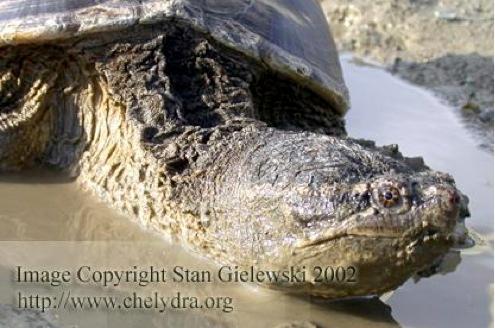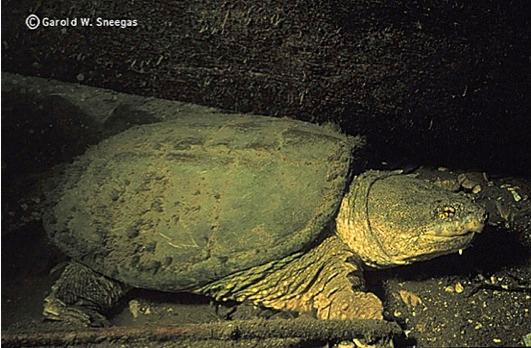Common Snapping Turtle
-
Scientific Name
Chelydra serpentina - Visit ITIS for full scientific classification.
-
Description
 Common snapping turtle close-up. © 2002 Stan Gielewski (www.chelydra.org)
Common snapping turtle close-up. © 2002 Stan Gielewski (www.chelydra.org) Common snapping turtle. © Garold W. Sneegas
Common snapping turtle. © Garold W. Sneegas- Large aquatic turtle with a massive head.
- Their top shell can be anywhere from 8 to over 19 inches in length.
- Average weight has been reported to be about 45 pounds, but in captivity they can grow over 75 pounds.
- The tail-end of its shell is heavily serrated.
- The tail is very long, potentially longer than the length of the shell.
- Usually a black, brown, or tan color.
- Skin can be a pale cream to yellowish color compared to the dark-colored shell.
- Large legs, heavy claws, and webbed toes.
-
Habitat
- Highly adaptable, found in a wide range of freshwater and brackish habitats.
- Rarely found basking in the sun, but spends most of the time resting buried in the mud, or sediment on the bottom of a water body.
-
Invasion Pathways and Distribution
- Native to the eastern and central U.S.
- Now found in areas throughout the U.S., including California.
- The means of introduction to California is unknown, but likely due to release by pet owners.
- See USGS for a map of current U.S. distribution.
-
Life History
- Adults become sexually mature at around 4 to 6 years.
- Females travel on land to build nests and lay eggs.
- Egg laying usually occurs in the summer months.
- It is estimated that individuals can live over 50 years.
-
Impacts
- Extremely adaptable, has a diverse diet, feeding on anything that it can swallow, including both plants and animals.
- Their impact is unknown, but it has the potential to be a food competitor and predator of native turtles.
-
References and Useful Links
For references by category and links to other useful AIS sites see our Learn More page.


